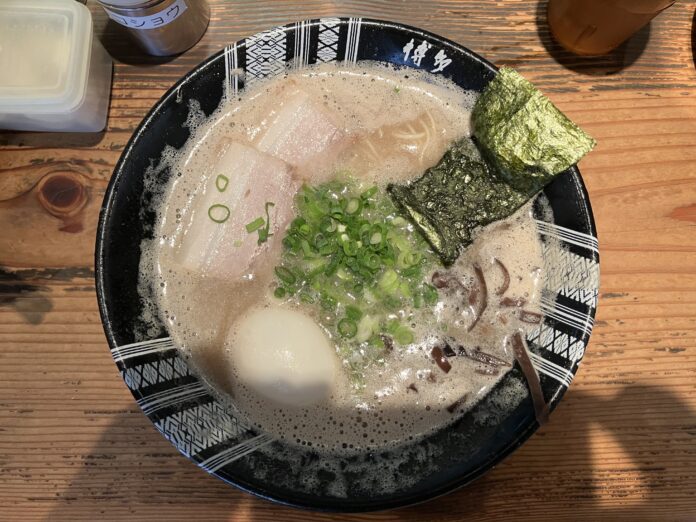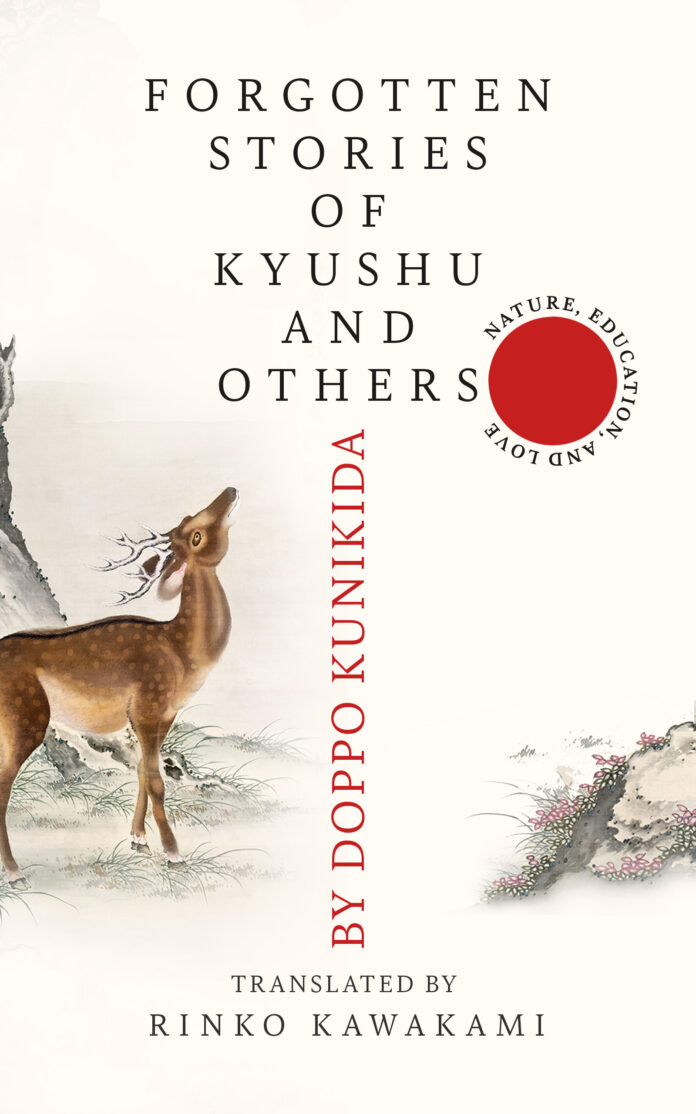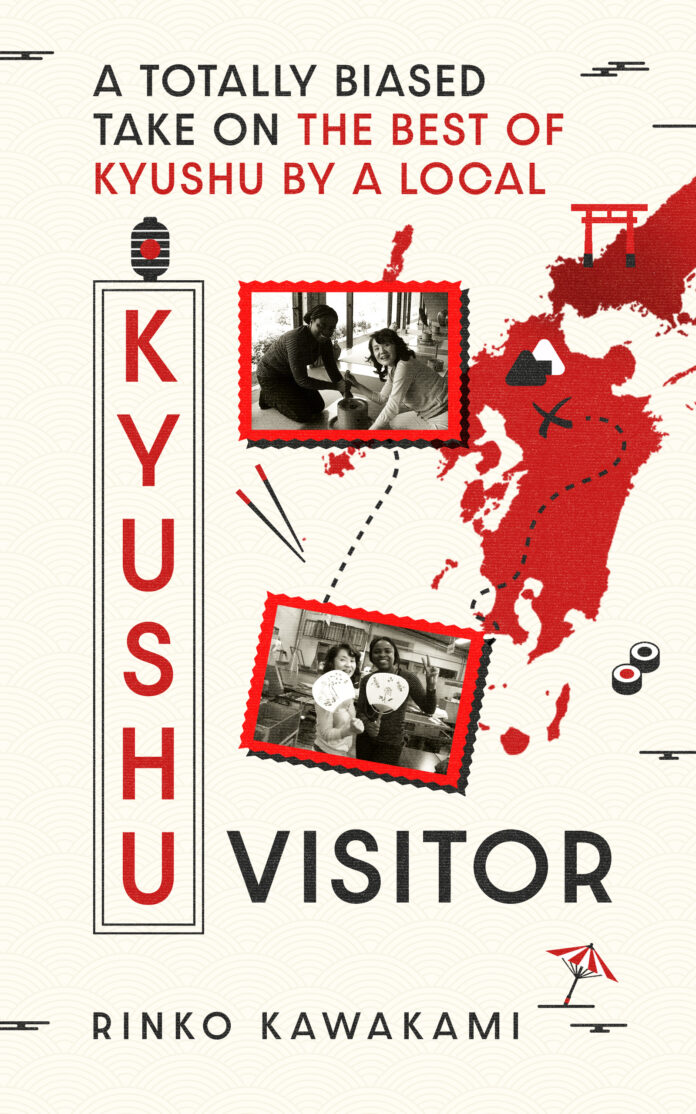When my friend from Los Angeles visited Fukuoka for the first time, there was one thing at the top of her list: Hakata ramen.
“I read in the guidebook that your hometown is famous for ramen,” she said with excitement. “This is something I must try!”
As a current Fukuoka resident, I knew exactly what she meant. Hakata ramen—rich, creamy, and deeply pork-based—is the pride of the region.
But as someone who grew up in Kurashiki, where ramen is typically served in a light soy sauce–based broth, I also understood something my friend didn’t: Hakata ramen can be intense.
For many first-timers—especially those used to the more delicate, chicken and small dried fish-based soups common in the Chūgoku region—the bold aroma and flavor of tonkotsu (a pork-bone broth simmered for many hours until rich and creamy) can come as a culinary shock.
In fact, soy sauce–based ramen is the style most people outside Japan imagine when they hear the word ramen.
So, considering how overwhelming Hakata ramen was even for a Japanese native like me, I’ve come to believe this:
Jumping into Hakata ramen without preparation is too advanced for ramen beginners from abroad.
My First Experience with Hakata Ramen: An Intense Ramen Reality Check
I remembered my own first encounter with Hakata ramen. I was eager, just like my friend. But when the steaming bowl arrived—with its milky white broth and unmistakable pork-bone aroma—I hesitated. One spoonful, and I realized I wasn’t prepared for just how deep and dense the flavor would be.
This experience taught me something important: Hakata ramen, as delicious and beloved as it is, may not be the best first step for everyone.
It’s a ramen style that demands attention—and a bit of readiness. That’s why, whenever friends from abroad come to visit, I take them on what I call a ramen rite-of-passage journey: a gradual introduction to Hakata’s boldest flavors, starting with gentler styles and slowly working our way toward the real thing.
In other words, for many people unfamiliar with ramen, trying Hakata ramen first can be a bit like jumping into the deep end without knowing how to swim. The richness and strong pork aroma may be overwhelming enough to turn them away from ramen altogether.
That would be a real shame, because ramen is far more than just one intense style. It is a vibrant and varied world of flavors, shaped by region, ingredients, tradition, and love of the people.
By easing into it step by step, newcomers can build an appreciation for the complexities and develop their own ramen favorites—making the whole experience far richer and more rewarding.
So, in this article, I’ll walk you through the steps that have worked not just for my foreign friends, but for myself, too—an outsider-turned-local who learned to love Hakata ramen one bowl at a time.
What Is Hakata Ramen, Really?
Hakata Ramen is a style of ramen that originated in the Hakata ward of Fukuoka City in southern Japan. It’s one of the most iconic regional ramen varieties, known for three defining characteristics (JTB Publishing, 2022):
- Rich, creamy pork bone broth (豚骨 tonkotsu, or 白濁の豚骨スープ hakudaku no tonkotsu sūpu)
This broth is made by boiling pork bones, fat, and collagen for many hours until the soup turns milky-white and develops a deep, savory flavor. The longer the broth is boiled over high heat, the more the water and fat particles blend together, promoting emulsification and resulting in a cloudy white soup (Takenaka, 2009).
- Extremely thin, firm noodles (極細麺 gokuboso men)
These straight, ultra-thin noodles are typically cooked to a firm texture, creating a balanced contrast with the rich broth.
- “Kaedama” system (替え玉 kaedama) This unique custom allows diners to order an extra serving of noodles to add to their remaining broth. You can request kaedama as many times as you’d like for an additional fee. It’s a hallmark of Hakata-style ramen and reflects the fast-paced, hearty eating culture of Fukuoka.
Three Major Ramen Styles of Fukuoka: Hakata Ramen, Kurume Ramen, and Nagahama Ramen
Hakata Ramen is considered one of the three major ramen styles of Fukuoka, alongside Kurume Ramen and Nagahama Ramen (Utagawa, 2025). Historically, it is said to have developed under the influence of Kurume Ramen, which originated in Kurume City, south of Hakata Ward, and Nagahama Ramen, from the Nagahama area in Fukuoka’s Chūō Ward.
The distinction between Hakata and Nagahama Ramen, in particular, is rather blurry (Koizumi, 2010). As Nagahama is not geographically part of Hakata Ward, the two styles are often categorized separately for convenience. However, in terms of flavor and ingredients, they are largely similar.
If anything, it’s often said that Nagahama Ramen has a slightly richer or more intense flavor compared to Hakata Ramen.
How Tonkotsu (Pork Bone) Broth Was Invented in Hakata Ramen
Tonkotsu ramen was invented by Tokio Miyamoto, the founder of the ramen stall “Nankin Senryō,” which opened in 1937 on Meiji Street in front of Nishitetsu Kurume Station in Kurume City (Fukuoka-ben Zenkoku Hōgen Kenkyūkai, 2013). After training at a shina soba restaurant in Tokyo, where he learned to use chicken bones and a small amount of pork bones, he perfected his original pork bone broth upon returning to Kurume.
Notably, Miyamoto was originally from Nagasaki, where he had grown up accustomed to the rich, creamy broth of Champon. This background is said to have influenced his creation of tonkotsu—or pork bone—soup, which would go on to become the signature of Hakata ramen.
One day in 1947, while simmering pork bones over a traditional stove (kamado), the broth boiled down and became cloudy while the owner was out. Not wanting to waste it, he added seasonings and tasted the soup — to his surprise, it was delicious. This accidental discovery gave birth to the now-famous milky-white tonkotsu ramen broth.
After World War II, ramen shops in the Hakata region began adopting this cloudy pork bone broth, and today, milky-white tonkotsu ramen is the standard for ramen in that area (Utagawa, 2025).
Ramen in Hakata, Fukuoka Prefecture, originally developed as a finishing dish (“shime”) eaten after mizutaki (a traditional chicken hot pot) from the Meiji era onward (BikeJin editorial team, 2023).
On the other hand, Nagahama ramen became a local specialty as a quick, satisfying meal served at food stalls (屋台, yatai) for workers at the fresh fish market, which was originally located in Hakata Ward but relocated to Nagahama in Chūō Ward in 1955.
This ramen features extremely thin noodles that cook quickly and a highly nutritious pork bone broth. Additionally, the unique custom of kaedama (ordering extra noodles) developed as part of this fast-paced yatai culture (BikeJin Editorial Team, 2023;Fukuoka-ben Zenkoku Hōgen Kenkyūkai, 2013).
In 1977, the proprietress of a ramen shop began calling it “Hakata Ramen,” and since then, the name Hakata Ramen has spread across Japan (Utagawa, 2025). This unique style—characterized by rich, creamy pork bone broth, extremely thin and firm noodles, and the kaedama system—has since become a household name.
Hakata Ramen and Kurume Ramen: Key Differences Explained
While Hakata ramen is characterized by extremely thin, firm noodles, Kurume ramen uses medium-thick straight noodles and features a broth that is even richer and heavier than that of Hakata.
The secret behind this difference lies in Kurume ramen’s unique soup-making method.
Known as “yobimodoshi” (呼び戻しliterally, “bringing back”), this technique involves adding fresh broth to leftover soup from the previous day and boiling it again over high heat. This process is repeated continuously, deepening the flavor and concentration of the soup over time (Oizumi & Takeuchi, 2015).
As a result, the surface of Kurume ramen’s cloudy white tonkotsu soup often has a noticeable layer of oil, and the aroma can include a fermented pork bone scent that is quite strong. In other words, the flavor may be a bit intense for ramen beginners.
Kurume ramen is best suited for advanced ramen diners who wish to deepen their understanding of tonkotsu ramen’s evolution or challenge themselves with bolder, more intense flavors.
Explore Flavor Transformation in Hakata Ramen: The Hidden Roles of Pickled Red Ginger and Spicy Pickled Mustard Greens
Karashi takana (spicy pickled mustard greens) and beni shoga (pickled red ginger) are iconic toppings of Hakata ramen. Many shops provide them free on the table, while some require ordering them as paid extras (JTB Publishing, 2022).
There is a cultural tradition in Hakata ramen of enjoying changes in flavor (Goodie Foodie editorial team, 2023). Although it’s not considered improper to eat the ramen without these toppings, many people adjust the taste by adding them to experience different flavor variations.
Typically, after savoring the rich, creamy tonkotsu broth with the refreshing tang of beni shoga—which changes both the taste and color of the soup—the meal is finished with the sharp, spicy kick of karashi takana.
My Suggested Ramen Rite of Passage: A Fukuoka Local’s Biased Recommendation
Now that you’ve gained a bit of background on the history and evolution of tonkotsu—pork bone—soup across different regions of Fukuoka, let me offer you my personal, and admittedly biased, step-by-step guide to enjoying it.
Here are the seven stages I recommend for easing into the world of tonkotsu ramen, especially if you’re a first-timer or guiding friends from abroad.
You can jump to detailed articles about each ramen stop (some coming soon) by clicking on the bold restaurant names:
- Oreno Oshimen – Start your ramen journey with a soy sauce–based bowl in a quirky spot inspired by Japan’s underground idol culture.
- Hayakawa – Move on to a mellow miso-based bowl, offering a flavor profile distinct from your usual miso soup.
- Unari – Explore a balanced middle ground with a fusion of tonkotsu and seafood broth—a gentle transition toward deeper flavors.
- Nagahama Number One – Savor a bowl steeped in yatai (food stall) history and culture.
- Hakata Issou – Level up with a rich, creamy bowl of authentic Hakata-style tonkotsu ramen—what some locals call “Hakata’s treasure.”
- Ajino Katsueda – Sample champon and discover how its hearty, pork-based broth might have inspired the creation of tonkotsu ramen.
- Kurume Honda Shōten – For seasoned ramen lovers, this deep, bold, and fermented-flavor bowl represents the height of tonkotsu tradition—especially with its use of the yobimodoshi technique.
Ramen is not just a dish—it’s a reflection of passion, dedication, local bounty, and deep-rooted history
Among my foreign friends, there are still some whose idea of ramen is limited to Nissin Cup Noodle. While Cup Noodle represents Japanese ingenuity and technological prowess, tasting various bowls of ramen firsthand will show you—both in your stomach and soul—that ramen truly embodies passion, hours of labor, the regional bounty of nature, and a history as diverse as Japan itself.
References
BikeJin Editorial Team. (2017, February 15). Tsūringu gaido Kyūshū Okinawa [Touring guide Kyushu and Okinawa]. Ei Publishing.
Fukuoka-ben Zenkoku Hōgen Kenkyūkai. (2013). Shabette minshai [Why not speak Fukuoka dialect?]. Riberaru-sha.
Goodie Foodie Editorial Team. (2023, May 29). Senmonten de kiita hontō ni oishii tabekata [Answer given at specialty restaurant on how to eat the right way]. Saizusha Co., Ltd.
JTB Publishing. (2022). Rurubu Kyushu ’23. JTB Publishing.
Koizumi, M. (2010). Neko manga [Cat manga] (Vol. 6). Takeshobo.
Oizumi, T., & Takeuchi, S. (2015). Ippai no tamashii: Rāmen jinbutsuden 3 [The soul of one bowl: Ramen character biography]. Gurūpu Zero.
Takenaka, S. (2009). Sōda! Rāmen-ya ni narō! [Yes! Let’s become a ramen shop owner!]. Nampō Shinsha.
Utagawa, K. (2025). Tabi to rekishi suki no tame no gotōchi gurume tanjō no himitsu [The secret of the birth of local gourmet for travel and history lovers]. Bere Shuppan.









